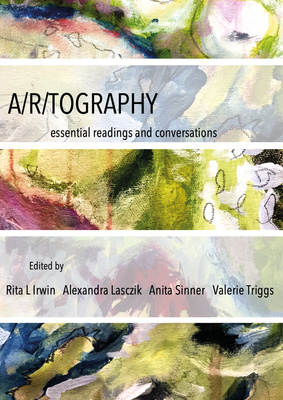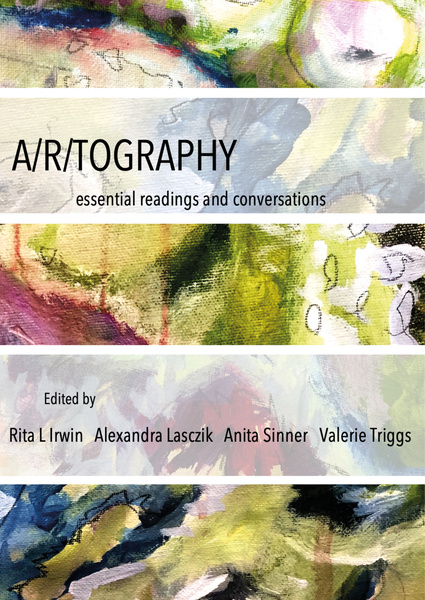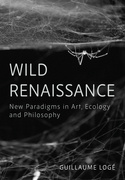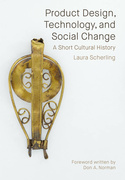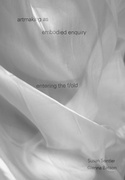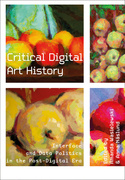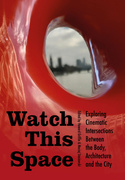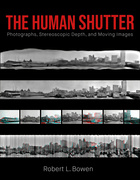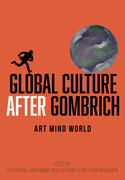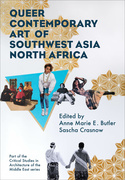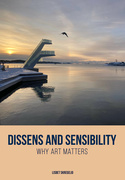A/r/tography (Book)
Essential Readings and Conversations
Working around the pervasive themes of relationality and renderings, ethics and embodiment, movement and materiality, and propositions and potentials, the volume simultaneously offers a site for the review of key historical works and at the same time, new scholarship that enters into conceptual conversations around a/r/tography.
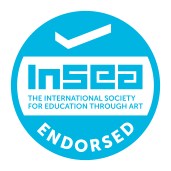
Edition
The focus of this edited book is to evoke and provoke conceptual conversations between early a/r/tographic publications and the contemporary scholarship of a/r/tographers publishing and producing today. Working around four pervasive themes found in a/r/tographic literature, this volume addresses relationality and renderings, ethics and embodiment, movement and materiality, and propositions and potentials.
In doing so, it advances concepts that have permeated a/r/tographic literature to date. More specifically, the volume simultaneously offers a site where key historical works can easily be found and at the same time, offer new scholarship that is in conversation with these historical ideas as they are discussed, expanded and changed within contemporary contexts. The organizing themes offer conceptual pivots for thinking through how a/r/tography was first conceptualized and how it has evolved and how it might further evolve.
Thus, this edited book affords an opportunity for all those working in and through a/r/tography to offer refined, revised, revisited or new conceptual understandings for contemporary scholarship and practice.
Part of the Artwork Scholarship: International Perspectives in Education series.
Rita L. Irwin is a distinguished university scholar and professor of art education at the University of British Columbia, Canada. As a scholar she is best known for her work in a/r/tography, teacher education, curriculum studies and sociocultural concerns.
Alexandra Lasczik is professor of arts and education in the Faculty of Education at Southern Cross University, Australia. She is currently associate dean research and director, Higher Degrees Research in the Faculty of Education. She is an expert educator with 40 years’ experience in the visual arts.
Anita Sinner is a Professor of Art Education at The University of British Columbia. Her interests include artwork scholarship, international art education, stories as research, and community art education.
Valerie Triggs is a professor in the Faculty of Education at the University of Regina. She has published research about teacher education field experience, curriculum theory and the ecological potential of aesthetic experience in pedagogic and curricular practice.
List of Figures
Land Acknowledgments
Acknowledgments
Foreword: On Practicing Intimacy – Stephanie Springgay
An Introduction – Rita L. Irwin, Alexandra Lasczik, Anita Sinner, and Valerie Triggs
Part I: Relationality and Renderings
Rendering Our Relations – Rita L. Irwin
Essential Readings
Chapter 1: A/r/tography: A Metonymic Métissage (2004) – Rita L. Irwin
Chapter 2: A/r/tography as Living Inquiry Through Art and Text (2005) – Stephanie Springgay, Rita L. Irwin, and Sylvia Wilson Kind
Chapter 3: Research and Creation: Socially Engaged Art in The City of Richgate Project (2010) – Ruth Beer and Rita L. Irwin with Kit Grauer and Gu Xiong
Chapter 4: A/r/tographic Collaboration as Radical Relatedness (2010) – Barbara Bickel, Stephanie Springgay, Ruth Beer, Rita L. Irwin, Kit Grauer, and Gu Xiong
Conversations
Chapter 6 A/r/tography: On Rendering a Selected Lexicon – Blake E. Smith
Chapter 7 Critical Softness in an A/r/tographic Affective Commonwealth – Nicole Y. S. Lee
Essential Readings
Chapter 9: Through the Looking Glass: Reflecting on an Embodied Understanding of Creativity and Creative Praxis as an A/r/tographer (2018) – Kathryn S. Coleman
Chapter 10: Inclusivity and Aesth/ethics in Third Participatory A/r/tographic Spaces (2014) – Marta Madrid Manrique
Chapter 11: (Re)Imagining Early Childhood Teacher Education—Belonging, Being, and Becoming in the Arts Through A/r/tography (2014) – Geraldine Burke, Corinna Peterken, Clare Hall, and Rosemary Bennett
Conversations
Chapter 14: A Different Difference: Ethics and Embodiment as Betweenness – Elly Yazdanpanah
Essential Readings
Chapter 16: A/r/tographic Peripatetic Inquiry and the Flâneur (2018) – Alexandra Lasczik Cutcher and Rita L. Irwin
Chapter 17: Educational Research, Photo Essays, and Film: Facts, Analogies, and Arguments in Visual A/r/tography (2013) – Ricardo Marin-Viadel, Joaquin Roldan, and Miguel A. Cepeda-Morales
Chapter 18: A/r/tography (2019) – Natalie LeBlanc and Rita L. Irwin
Conversations
Chapter 20: A/r/tographic Becomings, Choreographies, and Materialities – Sylvia Kind
Chapter 21: A/r/tography as Teacher in Movement and Materiality – Katie Hotko and Jemma Peisker
Part IV: Propositions and Potentiality
Actual Events – Valerie Triggs
Essential Readings
Chapter 23: Pedagogy and the A/r/tographic Invitation (2019) – Valerie Triggs and Rita L. Irwin
Chapter 24: Walking Propositions: Coming to Know A/r/tographically (2019) – Nicole Lee, Ken Morimoto, Marzieh Mosavarzadeh, and Rita L. Irwin
Conversations
Chapter 27: From a Desk in the A/r/tography Lab into the Future – Marzieh Mosavarzadeh
Chapter 28: Potentials and Propositions: Obliques Lived, Living, and Not-Yet Lived – Ken Morimoto
Part V: Afterword
Ways of Looking at the Oblique in A/r/tography (2012) – Carl Leggo
Notes on Contributors
Index

